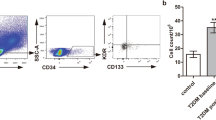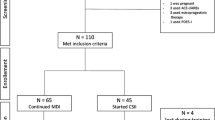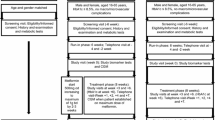Abstract
Purpose
Hypoglycemia is a barrier to the achievement of glycemic targets and limits the beneficial effects of improved glucose control on cardiovascular outcomes in type 2 diabetes (T2D). Circulating endothelial progenitor cells (EPCs) participate in cardiovascular homeostasis and predict future cardiovascular events. Therefore, we herein analyzed the association between occurrence of hypoglycemia and EPC changes in T2D patients after optimization of glucose control with basal insulin therapy.
Methods
In the NCT00699686 trial, 42 T2D insulin-naïve patients received a 3 + 3-month cross-over therapy with glargine and detemir. There were 43 minor and 2 severe hypoglycemic episodes in 19 patients (45.2 %, 0.54 episodes/patient/year). Changes in EPCs were analyzed in relation to the occurrence of hypoglycemia during the trial.
Results
Patients with hypoglycemia had a higher final HbA1c at 6 months than patients without, although absolute HbA1c changes were not significantly different. Though PCs increased at study end, in patients experiencing at least 1 hypoglycemic episode, the changes in CD34+, CD133+ progenitor cells and CD34+KDR+ EPCs were significantly lower than the respective changes in patients without incident hypoglycemia, even after correcting for confounders. During treatment with detemir, which induced >twofold less hypoglycemia than glargine, CD34+KDR+ EPCs increased significantly more than during treatment with glargine.
Conclusions
In naïve T2D patients initiating basal insulin, hypoglycemia prevents the increase in vasculoprotective PCs. Clinically, these data strengthen the importance of avoiding hypoglycemia to improve cardiovascular outcomes during the treatment of T2D.

Similar content being viewed by others
References
Inzucchi SE, Bergenstal RM, Buse JB, Diamant M, Ferrannini E, Nauck M, Peters AL, Tsapas A, Wender R, Matthews DR (2012) Management of hyperglycaemia in type 2 diabetes: a patient-centered approach. Position statement of the American Diabetes Association (ADA) and the European Association for the Study of Diabetes (EASD). Diabetologia 55(6):1577–1596. doi:10.1007/s00125-012-2534-0
Lundkvist J, Berne C, Bolinder B, Jonsson L (2005) The economic and quality of life impact of hypoglycemia. Eur J Health Econ 6(3):197–202. doi:10.1007/s10198-005-0276-3
Johnston SS, Conner C, Aagren M, Smith DM, Bouchard J, Brett J (2011) Evidence linking hypoglycemic events to an increased risk of acute cardiovascular events in patients with type 2 diabetes. Diabetes Care 34(5):1164–1170. doi:10.2337/dc10-1915
Boussageon R, Bejan-Angoulvant T, Saadatian-Elahi M, Lafont S, Bergeonneau C, Kassai B, Erpeldinger S, Wright JM, Gueyffier F, Cornu C (2011) Effect of intensive glucose lowering treatment on all cause mortality, cardiovascular death, and microvascular events in type 2 diabetes: meta-analysis of randomised controlled trials. BMJ 343:d4169. doi:10.1136/bmj.d4169
Wright RJ, Newby DE, Stirling D, Ludlam CA, Macdonald IA, Frier BM (2010) Effects of acute insulin-induced hypoglycemia on indices of inflammation: putative mechanism for aggravating vascular disease in diabetes. Diabetes Care 33(7):1591–1597. doi:10.2337/dc10-0013
Gogitidze Joy N, Hedrington MS, Briscoe VJ, Tate DB, Ertl AC, Davis SN (2010) Effects of acute hypoglycemia on inflammatory and pro-atherothrombotic biomarkers in individuals with type 1 diabetes and healthy individuals. Diabetes Care 33(7):1529–1535. doi:10.2337/dc09-0354
Nordin C (2010) The case for hypoglycaemia as a proarrhythmic event: basic and clinical evidence. Diabetologia 53(8):1552–1561. doi:10.1007/s00125-010-1752-6
Fadini GP, de Kreutzenberg SV, Mariano V, Boscaro E, Bertolini F, Mancuso P, Quarna J, Marescotti M, Agostini C, Tiengo A, Avogaro A (2011) Optimized glycaemic control achieved with add-on basal insulin therapy improves indexes of endothelial damage and regeneration in type 2 diabetic patients with macroangiopathy: a randomized crossover trial comparing detemir versus glargine. Diabetes Obes Metab 13(8):718–725. doi:10.1111/j.1463-1326.2011.01396.x
Fadini GP, Losordo D, Dimmeler S (2012) Critical reevaluation of endothelial progenitor cell phenotypes for therapeutic and diagnostic use. Circ Res 110(4):624–637. doi:10.1161/CIRCRESAHA.111.243386
Fadini GP, Maruyama S, Ozaki T, Taguchi A, Meigs J, Dimmeler S, Zeiher AM, de Kreutzenberg S, Avogaro A, Nickenig G, Schmidt-Lucke C, Werner N (2010) Circulating progenitor cell count for cardiovascular risk stratification: a pooled analysis. PLoS One 5(7):e11488. doi:10.1371/journal.pone.0011488
Fadini GP, Avogaro A (2010) Potential manipulation of endothelial progenitor cells in diabetes and its complications. Diabetes Obes Metab 12(7):570–583. doi:10.1111/j.1463-1326.2010.01210.x
Desouza CV (2013) Does drug therapy reverse endothelial progenitor cell dysfunction in diabetes? J Diabetes Complicat 27(5):519–525. doi:10.1016/j.jdiacomp.2013.04.007
Werner N, Kosiol S, Schiegl T, Ahlers P, Walenta K, Link A, Bohm M, Nickenig G (2005) Circulating endothelial progenitor cells and cardiovascular outcomes. N Engl J Med 353(10):999–1007. doi:10.1056/NEJMoa043814
Del Prato S (2009) Megatrials in type 2 diabetes. From excitement to frustration? Diabetologia 52(7):1219–1226. doi:10.1007/s00125-009-1352-5
Giorgino F, Leonardini A, Laviola L (2013) Cardiovascular disease and glycemic control in type 2 diabetes: now that the dust is settling from large clinical trials. Ann N Y Acad Sci 1281:36–50. doi:10.1111/nyas.12044
Dimmeler S, Aicher A, Vasa M, Mildner-Rihm C, Adler K, Tiemann M, Rutten H, Fichtlscherer S, Martin H, Zeiher AM (2001) HMG-CoA reductase inhibitors (statins) increase endothelial progenitor cells via the PI 3-kinase/Akt pathway. J Clin Invest 108(3):391–397. doi:10.1172/JCI13152
Banach M, Malodobra-Mazur M, Gluba A, Katsiki N, Rysz J, Dobrzyn A (2013) Statin therapy and new-onset diabetes: molecular mechanisms and clinical relevance. Curr Pharm Des 19(27):4904–4912. doi:10.2174/1381612811319270014
Esposito K, Maiorino MI, Di Palo C, Gicchino M, Petrizzo M, Bellastella G, Saccomanno F, Giugliano D (2011) Effects of pioglitazone versus metformin on circulating endothelial microparticles and progenitor cells in patients with newly diagnosed type 2 diabetes—a randomized controlled trial. Diabetes Obes Metab 13(5):439–445. doi:10.1111/j.1463-1326.2011.01367.x
Fadini GP, Boscaro E, Albiero M, Menegazzo L, Frison V, de Kreutzenberg S, Agostini C, Tiengo A, Avogaro A (2010) The oral dipeptidyl peptidase-4 inhibitor sitagliptin increases circulating endothelial progenitor cells in patients with type 2 diabetes: possible role of stromal-derived factor-1alpha. Diabetes Care 33(7):1607–1609. doi:10.2337/dc10-0187
Meneghini L, Kesavadev J, Demissie M, Nazeri A, Hollander P (2013) Once-daily initiation of basal insulin as add-on to metformin: a 26-week, randomized, treat-to-target trial comparing insulin detemir with insulin glargine in patients with type 2 diabetes. Diabetes Obes Metab 15(8):729–736. doi:10.1111/dom.12083
Katayama Y, Battista M, Kao WM, Hidalgo A, Peired AJ, Thomas SA, Frenette PS (2006) Signals from the sympathetic nervous system regulate hematopoietic stem cell egress from bone marrow. Cell 124(2):407–421. doi:10.1016/j.cell.2005.10.041
Albiero M, Poncina N, Tjwa M, Ciciliot S, Menegazzo L, Ceolotto G, Vigili de Kreutzenberg S, Moura R, Giorgio M, Pelicci P, Avogaro A, Fadini GP (2014) Diabetes causes bone marrow autonomic neuropathy and impairs stem cell mobilization via dysregulated p66Shc and Sirt1. Diabetes 63(4):1353–1365. doi:10.2337/db13-0894
Conflict of interest
The authors declare they have no conflict of interest.
Ethical approval
All procedures performed in studies involving human participants were in accordance with the ethical standards of institutional and national research committee and with the 1964 Helsinki declaration and its later amendments or comparable ethical standards.
Informed consent
Informed consent was obtained in all individual participants included in the study.
Author information
Authors and Affiliations
Corresponding author
Rights and permissions
About this article
Cite this article
Fadini, G.P., Albiero, M., Vigili de Kreutzenberg, S. et al. Hypoglycemia affects the changes in endothelial progenitor cell levels during insulin therapy in type 2 diabetic patients. J Endocrinol Invest 38, 733–738 (2015). https://doi.org/10.1007/s40618-015-0247-1
Received:
Accepted:
Published:
Issue Date:
DOI: https://doi.org/10.1007/s40618-015-0247-1




